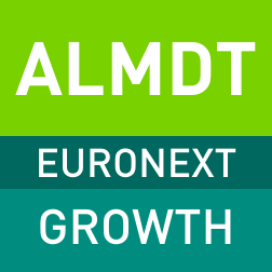Press Release – For Immediate Release – 5:45 pm CET
Median Technologies Reports Excellent Results from Its Independent Verification Study
In an important milestone towards market introduction, Median Technologies announces that its CADe/CADx Software as Medical Device (SaMD), eyonis™ LCS, has demonstrated excellent performance in an independent verification study—a critical step in the regulatory process for obtaining 510(k) clearance and CE marking.
- The independent verification’s purpose is to validate SaMD eyonis™ LCS’ performance on a novel patient cohort which is a critical phase prior to the pivotal studies for any SaMD device.
- A new, proprietary algorithm, developed in the latter half of 2023, has shown significantly enhanced results compared to its predecessor, tested during the second half of 2022 and the first half of 2023.
- The updated SaMD eyonis™ LCS achieved an Area Under the Curve (AUC) of 0.93, significantly surpassing the primary endpoint of AUC 0.80 for the pivotal standalone study for regulatory clearance.
- With its strong medico-economic potential, the new algorithm will be used in the two remaining pivotal studies, targeting 510(k) clearance and marketing authorization in the United States by Q1 2025, and CE marking for the European market by mid-2025, in line with EU regulations.
Median Technologies (FR0011049824, ALMDT, PEA/SME eligible) today announces that it has achieved very positive results from the independent verification study for its CADe/CADx[1] SaMD eyonis™[2] LCS (Lung Cancer Screening).
This evaluation utilizes retrospective patient data from diverse sources, setting the stage for the two forthcoming pivotal studies—analytical validation with the Standalone study (REALITY, MT-LCS-002) and clinical validation with the Multi-Reader Multi-Case study (RELIVE, MT-LCS-004)—in line with discussions during FDA Q-Submissions.
Innovations Leading to Enhanced Performance
The study compared two versions of SaMD eyonis™ LCS, spotlighting a new algorithm developed in H2 2023 that significantly improved the detection and characterization of malignant lung nodules, achieving an AUC[3] of 0.93 with 92% of sensitivity and 85% of specificity at patient level (Youden Index) in a cohort of 300 patients. This marks a major step forward from the 2022 algorithm’s AUC of 0.91 with 84% of sensitivity and 87% of specificity at patient level (Youden Index), demonstrating Median’s commitment to continuous innovation and excellence in medical technology.
The primary endpoint for the SaMD eyonis™ LCS used in the independent verification study is the same as the primary endpoint set in the pivotal Standalone study, i.e. measurement of AUC at patient level. The value to be achieved in the eyonis™ LCS Standalone study for 510(k) clearance and CE marking is an AUC greater than 0.80.
Implications for Global Health
The results obtained in the independent verification study conducted with the new version of the SaMD eyonis™ LCS add significant momentum to Median Technologies regarding the remaining validation steps leading towards regulatory approvals in the United States and Europe. They also maximize the medico-economic impact the SaMD eyonis™ LCS could have for the early diagnosis of lung cancer and for the development of screening programs, while strengthening the Company for future negotiations with payers in the United States and Europe.
In order to integrate the new algorithm, Median is now aiming for FDA 510(k) clearance for its CADe/CADx SaMD eyonis™ LCS in the first quarter of 2025 and CE marking by the end of the first half of 2025.
Strategic Focus and Global Impact
“The integration of the new version of our algorithm, will give us a decisive competitive advantage and significantly impact the early diagnosis of lung cancer—the leading cause of cancer death globally“ emphasizes Fredrik Brag, CEO and founder of Median Technologies. “Early diagnosis of lung cancer is already effective and has been reimbursed since 2015 in the United States as part of a screening program that currently covers a target population of 14.5 million Americans. Since July 2022, the use of tissue characterization software has been covered by a temporary reimbursement code of $650 per patient representing a very significant total addressable market for our SaMD eyonis™ LCS. In Europe, the organization of national lung screening programs for targeted populations is one of the recommendations made by the European Union in the “Europe’s Beating Cancer” plan. It has been considerably reinforced by the publication in November 2023 of the 2024-2029 Manifesto Time to accelerate: Together Against Cancer[4]“, adds Fredrik Brag.
[1] A radiological CADe device is “intended to identify, mark, highlight or otherwise direct attention to portions of an image that may reveal abnormalities during interpretation of images by the clinician.” A CADx device is “intended to provide information beyond identifying abnormalities, such as an assessment of disease.” Source: FDA
[2] Formerly known as iBiopsy®
[3] AUC ROC or AUROC (Area Under the ROC Curve) is a global performance metric used in machine learning to evaluate classification models. It’s derived from the Receiver Operating Characteristic (ROC) curve. The AUC measures the entire two-dimensional area underneath the ROC curve. AUC values range from 0 to 1, where an AUC of 1 indicates perfect classification power and an AUC of 0.5 suggests the model has no discrimination capacity, equivalent to random guessing. An AUC below 0.5 implies the model performs worse than random.

 Pioneering innovative imaging services and Software as Medical Devices, Median Technologies harnesses cutting-edge AI to enhance the accuracy of early cancer diagnoses and treatments. Median’s offerings include iCRO, which provides medical image analysis and management in oncology trials, and eyonis™, an AI/ML tech-based suite of software as medical devices (SaMD). Median empowers biopharmaceutical entities and clinicians to advance patient care and expedite the development of novel therapies. The French-based company, with a presence in the U.S. and China, trades on the Euronext Growth market (ISIN: FR0011049824, ticker: ALMDT). Median is also eligible for the French SME equity savings plan scheme (PEA-PME). For more information, visit
Pioneering innovative imaging services and Software as Medical Devices, Median Technologies harnesses cutting-edge AI to enhance the accuracy of early cancer diagnoses and treatments. Median’s offerings include iCRO, which provides medical image analysis and management in oncology trials, and eyonis™, an AI/ML tech-based suite of software as medical devices (SaMD). Median empowers biopharmaceutical entities and clinicians to advance patient care and expedite the development of novel therapies. The French-based company, with a presence in the U.S. and China, trades on the Euronext Growth market (ISIN: FR0011049824, ticker: ALMDT). Median is also eligible for the French SME equity savings plan scheme (PEA-PME). For more information, visit